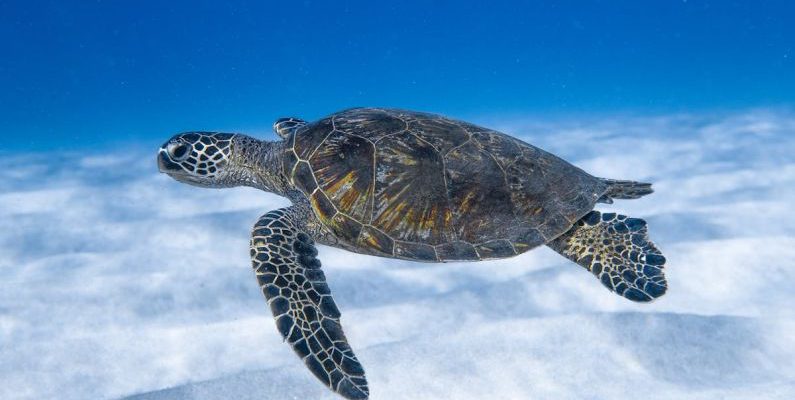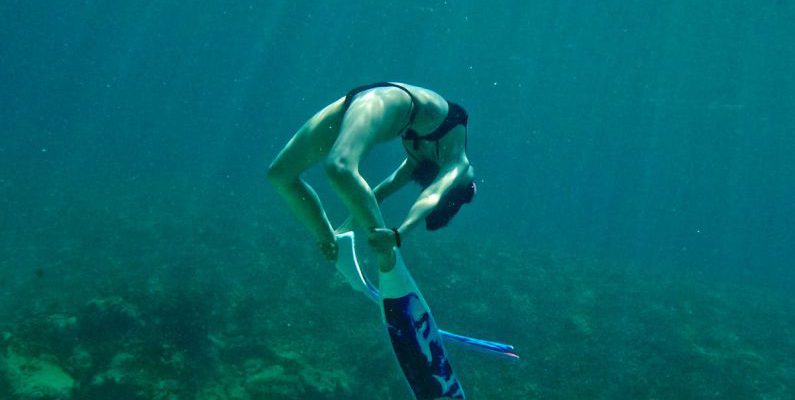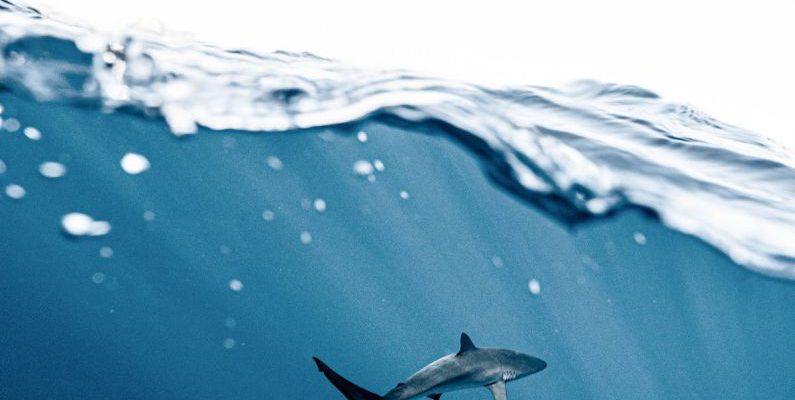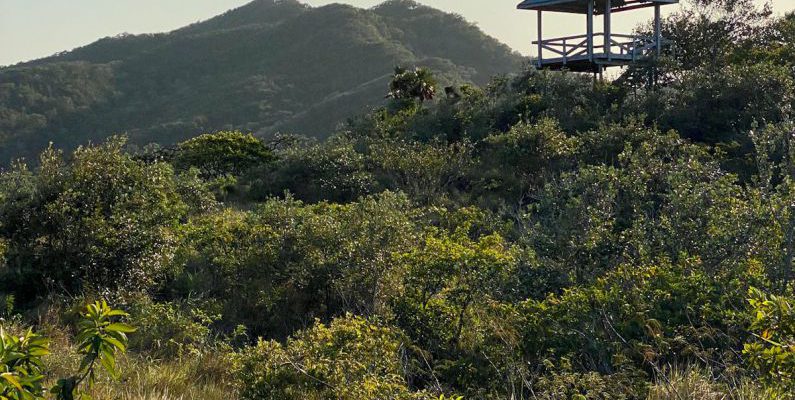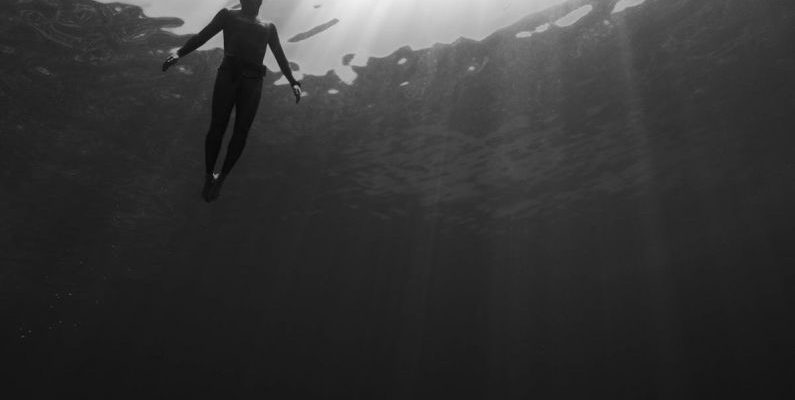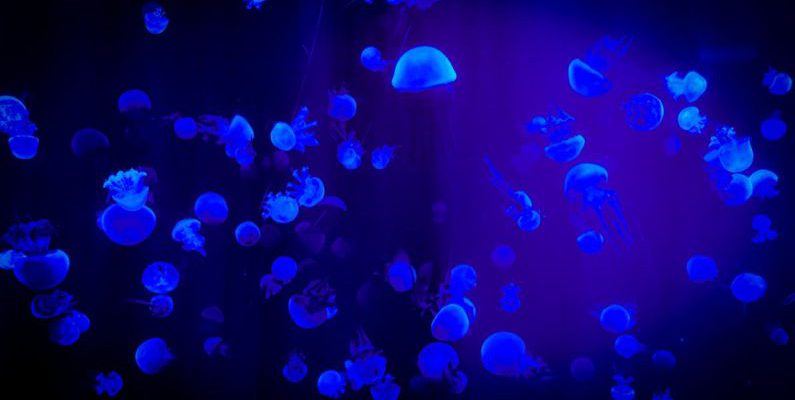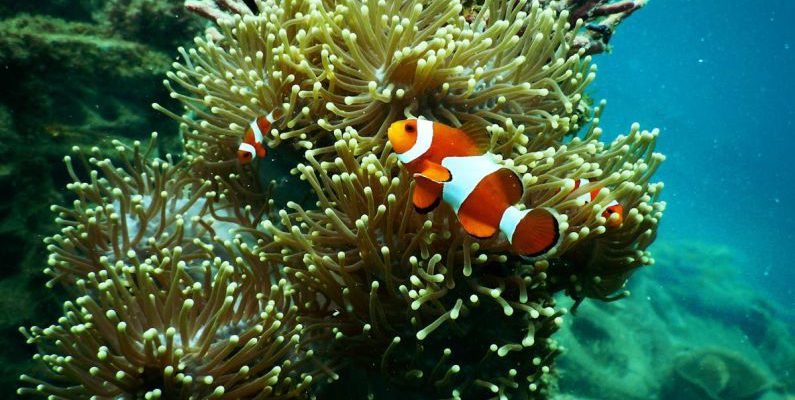Author: diveholidayisle
In Marine Life
The ocean covers more than 70% of the Earth's surface, and within its depths lies a world that is still largely unexplored. The deep sea, with its mysterious and extreme conditions, is home to some of the most bizarre and fascinating creatures on the planet. From bioluminescent jellyfish to giant squid, the deep sea is filled with creatures that challenge our understanding of life on Earth.
The Abyssal Zone: A World of Darkness and Pressure
One of the most inhospitable regions of the ocean is the abyssal zone, where sunlight cannot penetrate and pressure reaches crushing levels. Despite these extreme conditions, life thrives in this dark and cold environment. Deep-sea creatures in the abyssal zone have evolved unique adaptations to survive in such harsh conditions. One of the most bizarre deep-sea creatures found in the abyssal zone is the anglerfish. Known for its bioluminescent lure that hangs in front of its mouth, the anglerfish uses this light to attract prey in the darkness. The male anglerfish is significantly smaller than the female and attaches itself to her body, essentially becoming a parasite. This unique reproductive strategy is just one example of the strange and fascinating adaptations that deep-sea creatures have developed to survive in their extreme environment.Creatures of the Midnight Zone: Bioluminescence and Adaptations
Descending even deeper into the ocean, we enter the midnight zone, where sunlight cannot reach and temperatures drop to near freezing. Despite the darkness, the midnight zone is a place of vibrant bioluminescence, with many deep-sea creatures producing their own light to communicate, attract prey, or deter predators. One of the most mesmerizing deep-sea creatures found in the midnight zone is the vampire squid. Despite its ominous name, the vampire squid is a small, harmless creature that uses bioluminescent light to confuse its predators. With its webbed arms and red eyes, the vampire squid is a testament to the incredible diversity of life in the deep sea.The Hadal Zone: Extreme Depths and Unseen Creatures
The hadal zone, which includes the deepest parts of the ocean such as the Mariana Trench, is the least explored and most extreme environment on Earth. At depths exceeding 6,000 meters, the creatures that inhabit the hadal zone have evolved to withstand immense pressure and complete darkness. One of the most enigmatic deep-sea creatures found in the hadal zone is the giant isopod. Resembling a prehistoric creature, the giant isopod is a scavenger that feeds on the carcasses of dead animals that sink to the ocean floor. With its armored exoskeleton and powerful jaws, the giant isopod is a formidable predator in the deep sea.Unveiling the Mysteries of the Deep
The deep sea is a realm of endless mystery and discovery, with new species being found on a regular basis. From the bizarre adaptations of anglerfish to the otherworldly beauty of bioluminescent jellyfish, the deep sea is a treasure trove of strange and wonderful creatures that continue to captivate scientists and explorers alike. As we continue to explore the depths of the ocean, who knows what otherworldly creatures we may encounter and what secrets of the deep sea we may uncover.
In Dive Sites
Nestled in the southern Caribbean, the island of Bonaire is a diver's paradise renowned for its crystal-clear waters, vibrant marine life, and breathtaking coral reefs. Diving in Bonaire offers a unique and unparalleled underwater experience that attracts diving enthusiasts from around the globe. Whether you are a seasoned diver or a beginner looking to explore the wonders of the deep blue sea, Bonaire has something to offer for everyone.
Unparalleled Underwater Visibility
One of the most captivating aspects of diving in Bonaire is the unparalleled underwater visibility. With visibility often exceeding 100 feet, divers have the opportunity to immerse themselves in a world of vibrant colors and marine diversity. The crystal-clear waters of Bonaire provide an ideal environment for underwater exploration, allowing divers to witness the beauty of the coral reefs and the myriad of sea creatures that call these waters home.Vibrant Coral Reefs
Bonaire is home to some of the healthiest coral reefs in the Caribbean, making it a mecca for underwater photographers and marine enthusiasts. The reefs surrounding the island are teeming with life, from colorful reef fish to majestic sea turtles and graceful eagle rays. Diving in Bonaire offers the chance to witness these magnificent creatures up close in their natural habitat, creating unforgettable moments that will stay with you long after you resurface.Marine Diversity
The waters of Bonaire are home to a diverse array of marine species, making each dive a unique and exciting experience. From tiny seahorses to massive groupers, the marine life in Bonaire is as varied as it is spectacular. Divers can explore a multitude of dive sites around the island, each offering a different glimpse into the rich underwater ecosystem of Bonaire. Whether you are interested in macro photography or simply enjoy observing marine life in its natural habitat, Bonaire has something for everyone.Shore Diving Paradise
Bonaire is famous for its shore diving opportunities, with easy access to the underwater world right from the shore. The island boasts over 60 dive sites that are easily accessible from the beach, allowing divers to explore at their own pace without the need for a boat. Shore diving in Bonaire offers the freedom to dive whenever you please, making it a convenient and enjoyable experience for divers of all skill levels.Conservation and Sustainability
Bonaire has a long-standing commitment to marine conservation and sustainability, with strict regulations in place to protect its fragile underwater ecosystem. The island's Marine Park is a designated protected area that aims to preserve the health of the reefs and ensure the long-term sustainability of the marine environment. Divers in Bonaire can dive with peace of mind knowing that their underwater adventures are contributing to the preservation of this precious natural resource.A Diving Destination Like No Other
Diving in Bonaire is an experience like no other, offering a unique blend of natural beauty, marine diversity, and conservation efforts that set it apart as a premier diving destination. Whether you are drawn to the crystal-clear waters, vibrant coral reefs, or the opportunity to dive from the shore, Bonaire has something for every diver to discover and enjoy. Immerse yourself in the wonders of the deep blue sea and explore the magic that awaits beneath the surface in this Caribbean gem.
In Eco Diving
Diving enthusiasts around the world are increasingly seeking ways to explore the underwater world while minimizing their impact on the environment. Eco diving programs and courses have emerged as a popular choice for divers who want to enjoy the beauty of marine life responsibly. These initiatives not only focus on preserving the delicate ecosystems beneath the surface but also educate divers on sustainable diving practices. Let's delve into the world of eco diving and discover the range of programs and courses available for environmentally conscious divers.
Understanding Eco Diving
Eco diving, also known as environmentally friendly diving or green diving, is a concept that promotes sustainable diving practices to protect marine ecosystems. By minimizing disturbances to underwater habitats and marine life, eco divers aim to preserve the delicate balance of the ocean environment. This approach involves respecting marine life, avoiding physical contact with corals and other organisms, and reducing pollution through proper waste disposal. Eco diving goes beyond just enjoying the underwater world; it involves actively contributing to the conservation of marine resources. Divers who participate in eco diving programs gain a deeper appreciation for the ocean and become advocates for marine conservation.Eco Diving Programs
Numerous organizations and dive operators offer eco diving programs that cater to divers of all skill levels. These programs combine diving activities with environmental education and conservation efforts, providing participants with a holistic diving experience. One popular eco diving program is the Reef Check EcoDiver course, which trains divers to monitor and assess coral reef health. Participants learn how to identify key indicator species, collect data on reef conditions, and contribute to ongoing research and conservation efforts. By becoming certified Reef Check EcoDivers, individuals can actively participate in reef monitoring projects worldwide. Another notable eco diving program is the Project AWARE Specialty course, which focuses on underwater conservation and marine debris management. Divers learn about the impact of pollution on marine ecosystems and how they can participate in clean-up initiatives to protect the ocean environment. Through hands-on activities and educational sessions, divers gain the knowledge and skills to become effective ocean advocates.Eco Diving Courses
In addition to structured eco diving programs, divers can also enroll in specialized courses that focus on environmental conservation and sustainability. These courses cover a wide range of topics, including marine biology, coral reef ecology, and sustainable diving practices. One example of an eco diving course is the Marine Conservation course, which provides divers with in-depth knowledge of marine ecosystems and the threats they face. Participants learn about the importance of marine biodiversity, the impact of climate change on ocean health, and strategies for marine conservation. By understanding these key concepts, divers can make informed decisions to protect the marine environment during their dives. Another popular eco diving course is the Dive Against Debris Specialty course, which teaches divers how to conduct underwater clean-up operations and report debris data to a global database. Participants learn how to remove marine debris safely, document their findings, and contribute to the fight against ocean pollution. This course empowers divers to take action against marine debris and make a positive impact on the underwater world.Exploring Eco Diving Opportunities
As eco diving continues to gain traction within the diving community, divers have a wealth of opportunities to participate in environmentally friendly diving initiatives. Whether through structured programs or specialized courses, divers can engage in conservation efforts, contribute to scientific research, and promote sustainable diving practices. By embracing eco diving principles and incorporating them into their diving activities, divers can play a vital role in protecting the ocean environment for future generations. Through education, awareness, and action, eco divers can make a difference in preserving the beauty and biodiversity of the underwater world. Join the eco diving movement today and dive responsibly for a sustainable future.
The thrill of encountering sharks up close is an experience that leaves a lasting impression on those brave enough to dive into the depths of South Africa's waters. Known for its diverse marine life and crystal-clear visibility, South Africa offers a unique opportunity for adventure seekers to come face to face with these majestic creatures. From the adrenaline rush of cage diving with great whites to the awe-inspiring sight of graceful tiger sharks gliding through the water, a shark encounter in South Africa is a truly unforgettable experience.
**Diving with Great Whites**
One of the most iconic shark encounters in South Africa is cage diving with great white sharks. Gansbaai, located along the Western Cape, is renowned as one of the best places in the world to come face to face with these apex predators. The experience of being just inches away from a massive great white shark as it effortlessly glides past the cage is both exhilarating and humbling. The crystal-clear waters provide a perfect backdrop for observing these powerful creatures in their natural habitat.
**Swimming with Tiger Sharks**
For those seeking a more intimate encounter with sharks, Aliwal Shoal off the coast of KwaZulu-Natal is a prime destination for swimming with tiger sharks. Known for their distinctive stripes and graceful movements, tiger sharks are a sight to behold underwater. Swimming alongside these majestic creatures offers a rare opportunity to witness their beauty up close and personal. The warm waters of Aliwal Shoal provide the perfect setting for a peaceful and awe-inspiring encounter with these gentle giants of the sea.
**Encountering Ragged-Tooth Sharks**
Another popular shark encounter in South Africa is diving with ragged-tooth sharks at Protea Banks. These prehistoric-looking creatures, with their jagged teeth and formidable appearance, may seem intimidating at first glance. However, ragged-tooth sharks are known for their docile nature and are a favorite among divers for their calm demeanor. Observing these sharks in their natural habitat is a mesmerizing experience that highlights the unique beauty of these often misunderstood creatures.
**The Thrill of Shark Encounters**
The thrill of coming face to face with sharks in South Africa is unmatched. The adrenaline rush of being in such close proximity to these powerful predators is a feeling that cannot be replicated. Whether diving with great whites, swimming with tiger sharks, or encountering ragged-tooth sharks, each experience offers a unique perspective on the world beneath the waves. The sheer beauty and grace of these creatures serve as a reminder of the importance of conservation efforts to protect their habitats and ensure their continued existence.
**Preserving the Ocean's Ecosystem**
Shark encounters in South Africa not only provide an unforgettable experience for thrill-seekers but also underscore the importance of preserving the ocean's delicate ecosystem. Sharks play a crucial role in maintaining the balance of marine life and are essential to the health of our oceans. By promoting responsible tourism practices and supporting conservation initiatives, we can help protect these magnificent creatures for future generations to enjoy.
In conclusion, shark encounters in South Africa offer a rare opportunity to witness the beauty and majesty of these incredible creatures up close. Whether diving with great whites, swimming with tiger sharks, or encountering ragged-tooth sharks, each experience provides a unique perspective on the world beneath the surface. By embracing these encounters with respect and appreciation, we can contribute to the conservation efforts needed to safeguard the ocean's ecosystem and ensure the survival of sharks for years to come.
In Dive Sites
Roatan, a picturesque island in the Caribbean Sea, is a diver's paradise waiting to be explored. With its crystal-clear waters, vibrant coral reefs, and diverse marine life, Roatan offers an unparalleled diving experience for both beginners and seasoned divers. If you're planning a diving trip to this tropical haven, here is the ultimate guide to help you make the most of your underwater adventure.
**Choosing the Right Dive Sites**
Roatan boasts a wide range of dive sites that cater to divers of all skill levels. From shallow reefs teeming with colorful fish to deep wrecks and walls for the more experienced diver, there is something for everyone. Popular sites like Mary's Place, a stunning wall dive with overhangs and crevices, and the wreck of the El Aguila, a sunken cargo ship, offer unique underwater experiences that will leave you in awe.
**Best Time to Dive**
The best time to dive in Roatan is during the dry season, which runs from December to April. During this time, you can expect clear skies, calm seas, and excellent visibility underwater. However, diving is possible year-round in Roatan, with the rainy season from May to November offering a chance to see different marine life and experience fewer crowds.
**Diving Conditions**
The waters around Roatan are warm and inviting, with temperatures ranging from 78°F to 84°F throughout the year. Visibility is generally excellent, often exceeding 100 feet, allowing divers to marvel at the vibrant coral gardens and abundant marine life that call these waters home. Currents are usually mild, making diving in Roatan suitable for divers of all experience levels.
**Marine Life**
Roatan is home to a diverse array of marine life, from colorful reef fish to larger pelagics such as eagle rays, sharks, and even whale sharks during certain times of the year. Keep an eye out for seahorses, moray eels, and nudibranchs hiding among the corals, and don't forget to look up to spot schools of jacks, barracudas, and the occasional passing turtle.
**Dive Operators and Facilities**
Roatan is home to numerous dive operators and resorts that cater to divers' needs. Whether you're looking for a guided dive experience, equipment rental, or certification courses, you'll find a range of options to suit your preferences. Many dive resorts on the island offer all-inclusive packages that include accommodation, meals, and diving, making it easy to plan a hassle-free diving vacation.
**Top Tips for Diving in Roatan**
- Always dive with a reputable dive operator who prioritizes safety and conservation.
- Respect the marine environment by not touching or disturbing marine life or corals.
- Check your equipment before each dive and ensure it is in good working condition.
- Stay hydrated and protect yourself from the sun while on the boat or between dives.
- Take only pictures and memories, leaving only bubbles behind to preserve Roatan's underwater beauty for future generations.
**Exploring Roatan Above Water**
When you're not exploring the underwater wonders of Roatan, take the time to discover the island's lush rainforests, pristine beaches, and vibrant culture. Visit the charming town of West End for delicious local cuisine and vibrant nightlife, or embark on a zip-lining adventure through the treetops for a different perspective of this tropical paradise.
**In Summary**
Diving in Roatan offers a truly unforgettable experience for divers of all levels. With its stunning dive sites, abundant marine life, and warm waters, Roatan is a must-visit destination for anyone seeking adventure beneath the waves. By following this ultimate guide, you'll be well-prepared to make the most of your diving trip to this Caribbean gem. Pack your dive gear, dive into the crystal-clear waters of Roatan, and prepare to be amazed by the underwater wonders that await you.
When embarking on a diving adventure during your travels, renting dive gear is a convenient option for many enthusiasts. Whether you're exploring a tropical reef or diving into a mysterious cenote, having the right equipment is essential for a safe and enjoyable experience. To ensure a smooth and hassle-free dive gear rental process, consider these valuable tips before you hit the water.
Research and Reserve in Advance
Before you depart for your trip, take the time to research dive shops or rental facilities at your destination. Look for reputable shops with positive reviews and a wide selection of well-maintained gear. Some dive shops may offer online booking options, allowing you to reserve your equipment in advance. By securing your rental gear ahead of time, you can avoid last-minute availability issues and ensure that the necessary items are ready for your dive adventures.Check the Condition of the Gear
When you arrive at the dive shop to pick up your rental gear, thoroughly inspect each item to ensure it is in good condition. Check the wetsuit for any tears or signs of wear, inspect the regulator for proper functioning, and ensure that the BCD inflates and deflates smoothly. If you notice any damage or defects, don't hesitate to ask for a replacement. It's essential to dive with well-maintained equipment to enhance your safety and comfort underwater.Communicate Your Preferences
When renting dive gear, it's crucial to communicate your preferences and requirements to the dive shop staff. Let them know your size for wetsuits, fins, and masks to ensure a proper fit. If you have any specific requests or concerns, such as a preference for a certain type of regulator or BCD, don't hesitate to discuss these with the rental staff. By communicating openly, you can ensure that the dive gear provided meets your needs and enhances your overall diving experience.Ask About Equipment Maintenance
Before finalizing your dive gear rental, inquire about the maintenance schedule and procedures followed by the dive shop. Well-maintained equipment is crucial for safe diving, so it's important to rent gear from a facility that prioritizes regular inspections and servicing. Ask when the equipment was last serviced and if there have been any recent issues with the gear. Renting from a shop that takes maintenance seriously can offer peace of mind and reduce the risk of equipment malfunctions during your dives.Pack Essentials for Personal Comfort
In addition to renting dive gear, don't forget to pack essential items for your personal comfort and safety. Consider bringing sunscreen, a reusable water bottle, a towel, and any necessary medications or dive certifications. Having these items on hand can enhance your overall diving experience and ensure that you are prepared for various conditions you may encounter during your underwater explorations.Stay Hydrated and Energized
Diving can be physically demanding, so it's essential to stay hydrated and energized throughout your dive trips. Make sure to drink plenty of water before and after your dives to prevent dehydration. Additionally, consider packing light snacks such as energy bars or fruit to maintain your energy levels during long diving excursions. Proper hydration and nutrition can help you stay focused and alert underwater, enhancing your overall diving experience.Embrace the Adventure
Renting dive gear while traveling opens up a world of underwater exploration and adventure. Embrace the opportunity to discover new dive sites, marine life, and underwater landscapes during your travels. Remember to respect the marine environment, follow safe diving practices, and enjoy the unique experience of diving in different locations around the world. By staying prepared, communicating effectively, and prioritizing safety, you can make the most of your dive gear rental experience and create unforgettable diving memories during your travels. In summary, renting dive gear while traveling can enhance your diving adventures and allow you to explore underwater worlds in different locations. By researching in advance, checking the condition of the gear, communicating your preferences, and staying prepared, you can ensure a smooth and enjoyable dive gear rental experience. Remember to prioritize safety, stay hydrated, and embrace the adventure as you immerse yourself in the wonders of the underwater realm during your travels. Happy diving!
Embarking on a diving trip is an exciting adventure that promises unforgettable underwater experiences. As a diver, proper preparation is key to ensure a safe and enjoyable journey. To make the most of your diving expedition, it's important to pack all the essential items you'll need for the trip. Here's a comprehensive checklist of travel essentials to help you gear up for your next diving adventure.
Gear and Equipment
Before setting off on your diving trip, it's crucial to ensure you have all the necessary gear and equipment in top condition. Here are the essential items you'll need: 1. Dive Certification and Logbook: Make sure you bring your dive certification card and logbook to show proof of your qualifications and track your dives. 2. Mask, Snorkel, and Fins: Your mask should fit comfortably and provide a good seal, while your snorkel and fins should be suitable for the type of diving you'll be doing. 3. Wetsuit or Drysuit: Depending on the water temperature at your dive destination, pack the appropriate exposure suit to stay warm and comfortable underwater. 4. Regulator and Buoyancy Control Device (BCD): Check that your regulator is properly serviced and your BCD is functioning correctly before your trip. 5. Dive Computer: A reliable dive computer is essential for monitoring your depth, bottom time, and decompression limits during dives. 6. Surface Signaling Devices: Carry signaling devices such as a surface marker buoy and whistle for safety and communication with your dive buddy and boat crew. 7. Spare Parts and Tools: Pack spare o-rings, fin straps, and other essential spare parts, along with tools for minor equipment repairs.Safety and First Aid
Safety should always be a top priority when diving. Be prepared for any unforeseen circumstances with the following safety and first aid essentials: 8. Emergency Contacts and Documents: Keep a list of emergency contacts, including your dive insurance information and any relevant medical history. 9. First Aid Kit: Pack a compact first aid kit with essentials like bandages, antiseptic wipes, pain relievers, and seasickness medication. 10. Dive Insurance: Ensure you have comprehensive dive insurance coverage for medical emergencies, equipment loss or damage, and trip cancellations. 11. Whistle and Dive Knife: Carry a whistle for signaling at the surface and a dive knife for cutting through entanglements if needed. 12. Reel or Safety Sausage: A reel or safety sausage can help you attract attention in case of an emergency or if you surface away from the boat.Comfort and Convenience
To enhance your diving experience and make your trip more comfortable, consider packing these additional items: 13. Towel and Change of Clothes: Bring a quick-drying towel and a change of clothes for after your dives to stay dry and comfortable. 14. Sun Protection: Pack sunscreen, lip balm with SPF, and a wide-brimmed hat to shield yourself from the sun's rays while on the boat or beach. 15. Water and Snacks: Stay hydrated and energized by carrying a reusable water bottle and nutritious snacks for between dives. 16. Underwater Camera: Capture stunning underwater moments with a compact underwater camera or action cam to document your dives. 17. Dive Light: If you plan on exploring wrecks or caves, a dive light can illuminate dark spaces and enhance your underwater visibility. 18. Mesh Bag: A mesh bag is handy for carrying and rinsing your gear, as well as collecting any trash or debris you encounter during your dives.Prepare for Your Diving Adventure
By packing these essential items in your dive bag, you can be well-prepared for a safe and enjoyable diving trip. Remember to double-check your gear, review your dive plan with your buddy, and always adhere to safe diving practices. With the right travel essentials in tow, you'll be ready to dive into the wonders of the underwater world and create lasting memories on your next diving adventure.
In Eco Diving
Scuba diving offers an unparalleled opportunity to explore the mesmerizing underwater world, but with great adventure comes great responsibility. Marine conservation is a crucial aspect of scuba diving, ensuring that the ecosystems we love to explore are protected and preserved for future generations. Engaging in marine conservation projects allows scuba divers to give back to the oceans that provide them with so much joy and wonder. Here are some impactful marine conservation projects that scuba divers can get involved in:
**Coral Restoration Initiatives**
Coral reefs are among the most biodiverse ecosystems on the planet, providing a habitat for countless marine species. Unfortunately, coral reefs are under threat from various factors, including climate change, pollution, and overfishing. Coral restoration projects aim to rehabilitate damaged reefs by growing and transplanting coral fragments. Scuba divers can participate in coral restoration efforts by assisting with coral planting, monitoring reef health, and collecting data on coral growth.
**Marine Debris Clean-Up**
Marine debris, particularly plastic pollution, poses a significant threat to marine life and ecosystems. Scuba divers can take part in underwater clean-up initiatives to remove litter and debris from the ocean floor. These clean-up efforts not only help protect marine life but also raise awareness about the impact of plastic pollution on the marine environment. By participating in marine debris clean-up projects, scuba divers play a vital role in preserving the health of our oceans.
**Shark Conservation Programs**
Sharks are apex predators that play a crucial role in maintaining the balance of marine ecosystems. However, shark populations are declining worldwide due to overfishing and habitat destruction. Scuba divers can support shark conservation efforts by volunteering with organizations that work to protect these magnificent creatures. Shark conservation programs may involve conducting research on shark populations, advocating for shark conservation policies, and promoting responsible shark tourism practices.
**Seagrass Restoration Projects**
Seagrass meadows are essential habitats that support a diverse array of marine life, including fish, turtles, and seahorses. However, seagrass ecosystems are threatened by coastal development, pollution, and climate change. Scuba divers can contribute to seagrass restoration projects by replanting seagrass beds, monitoring seagrass health, and participating in seagrass conservation research. Restoring and protecting seagrass habitats is crucial for maintaining the health and biodiversity of coastal ecosystems.
**Marine Protected Areas Monitoring**
Marine protected areas (MPAs) are designated areas of the ocean where human activities are restricted to conserve marine biodiversity. Scuba divers can assist in monitoring and enforcing regulations within MPAs to ensure that these areas remain effectively protected. By participating in MPA monitoring programs, divers can help safeguard vulnerable marine species and habitats from threats such as poaching and illegal fishing. Monitoring MPAs also provides valuable data for conservation research and management.
**Community Outreach and Education**
In addition to participating in hands-on conservation projects, scuba divers can also make a difference by engaging in community outreach and education initiatives. By sharing their passion for the ocean and raising awareness about marine conservation issues, divers can inspire others to take action to protect our seas. Organizing beach clean-ups, giving presentations at schools, and promoting sustainable diving practices are just a few ways divers can help educate the public about the importance of marine conservation.
**In Conclusion: Empowering Divers to Make a Difference**
Marine conservation projects offer scuba divers the opportunity to actively contribute to the protection and preservation of our oceans. By getting involved in initiatives such as coral restoration, marine debris clean-up, shark conservation, seagrass restoration, MPA monitoring, and community outreach, divers can make a positive impact on marine ecosystems and help ensure a sustainable future for our seas. Through their collective efforts, divers can be powerful advocates for marine conservation, inspiring others to join in the crucial work of protecting our precious underwater world.
Diving is a thrilling and rewarding experience that allows us to explore the wonders of the underwater world. Whether you are a beginner or an experienced diver, adding yoga to your routine can significantly enhance your diving skills and overall diving experience. The practice of yoga offers numerous physical and mental benefits that can help you improve your diving performance and enjoyment. Let's delve into how incorporating yoga into your routine can take your diving skills to the next level.
Enhanced Flexibility and Mobility
One of the key benefits of practicing yoga for diving is improved flexibility and mobility. Diving requires a wide range of motion in your joints, especially in the hips, shoulders, and spine. By regularly practicing yoga, you can increase your flexibility and range of motion in these key areas, allowing you to move more freely underwater. Poses such as the Downward Dog, Cobra Pose, and Pigeon Pose can help to stretch and open up tight muscles, making it easier for you to navigate the water with grace and ease.Improved Breathing Techniques
Proper breathing is essential for diving, as it helps you conserve energy, stay calm, and maintain buoyancy underwater. Yoga places a strong emphasis on breath awareness and control, teaching you how to breathe deeply and mindfully. By incorporating pranayama (breathwork) into your yoga practice, you can improve your lung capacity, enhance your breathing efficiency, and learn how to breathe in a more relaxed and controlled manner. These breathing techniques can be invaluable when you are underwater, helping you stay calm and focused in challenging diving situations.Strength and Endurance
Diving can be physically demanding, requiring strength and endurance to navigate currents, carry equipment, and maintain proper buoyancy. Yoga is an excellent way to build strength in your core, arms, legs, and back, all of which are essential for diving. Poses like Plank, Warrior II, and Boat Pose can help you develop the muscular strength needed to support your body and equipment underwater. Additionally, the flowing sequences and holds in yoga poses can help improve your endurance, allowing you to stay active and alert during longer dives.Mental Clarity and Focus
Clear mental focus is crucial for safe and enjoyable diving. Yoga is not just a physical practice; it also cultivates mental clarity, focus, and mindfulness. Through meditation and mindfulness practices in yoga, you can train your mind to stay present and focused, both on and off the mat. This mental discipline can be incredibly beneficial for diving, as it can help you stay calm, make quick decisions, and react effectively to changing underwater conditions. By incorporating yoga into your routine, you can enhance your mental resilience and concentration, ensuring a more enjoyable and safe diving experience.Stress Reduction and Relaxation
Diving can be an exhilarating but also stressful activity, especially for those new to the sport. Yoga offers a holistic approach to stress reduction, helping you relax your body and calm your mind. The deep breathing, gentle movements, and relaxation techniques in yoga can help lower your stress levels, reduce anxiety, and promote a sense of inner peace and tranquility. By incorporating yoga into your pre-dive routine, you can prepare your body and mind for the challenges of diving, allowing you to approach each dive with a sense of calm and serenity.Final Thoughts
In conclusion, the practice of yoga can be a valuable tool for divers looking to enhance their skills and enjoyment underwater. From improved flexibility and strength to enhanced breathing techniques and mental focus, yoga offers a wide range of benefits that can take your diving to the next level. By incorporating yoga into your routine, you can prepare your body and mind for the challenges of diving, ensuring a safe, enjoyable, and fulfilling underwater experience. So, roll out your mat, take a deep breath, and dive into the transformative power of yoga for divers.
In Marine Life
Coral reefs are among the most vibrant and diverse ecosystems on our planet, teeming with life and color beneath the crystal-clear waters. These underwater structures, formed by colonies of tiny organisms called coral polyps, play a crucial role in marine biodiversity and the health of our oceans. In this article, we will delve into the different types of coral reefs, the threats they face, and the conservation efforts aimed at preserving these invaluable natural wonders.
### Types of Coral Reefs
#### Fringing Reefs
Fringing reefs are the most common type of coral reef and are found close to the shorelines of continents and islands. These reefs grow directly from the shorelines and form a border along the coast, providing essential habitat for a wide variety of marine species. Fringing reefs often have a shallow lagoon between the reef and the shore, creating a unique ecosystem rich in biodiversity.#### Barrier Reefs
Barrier reefs, as the name suggests, are separated from the mainland or island by a lagoon. These reefs are typically larger and more developed than fringing reefs, with deeper lagoons between the reef and the shore. The Great Barrier Reef in Australia is the largest barrier reef in the world and is renowned for its stunning marine life and intricate coral formations.#### Atolls
Atolls are circular or horseshoe-shaped reefs that form around submerged volcanic islands or seamounts. Over time, as the volcanic island erodes and sinks, the coral reef continues to grow upward, creating a ring-shaped structure with a central lagoon. Atolls are often found in remote areas of the ocean and are home to a diverse array of marine species adapted to the unique conditions of these isolated ecosystems.### Threats to Coral Reefs
#### Climate Change
One of the most significant threats facing coral reefs today is climate change. Rising sea temperatures due to global warming can cause coral bleaching, a phenomenon in which corals expel the algae living in their tissues, leading to the loss of color and vital nutrients. Without these algae, corals become stressed and are more susceptible to disease and death, resulting in widespread coral bleaching events around the world.#### Ocean Acidification
Another consequence of climate change is ocean acidification, which occurs when the oceans absorb excess carbon dioxide from the atmosphere. This process lowers the pH of the water, making it more difficult for corals to build their calcium carbonate skeletons. Ocean acidification can weaken coral structures and hinder their growth and reproduction, ultimately threatening the long-term survival of coral reefs.#### Overfishing and Destructive Practices
Overfishing and destructive fishing practices, such as blast fishing and cyanide fishing, can devastate coral reef ecosystems by depleting fish populations and damaging coral structures. When key fish species are removed from the ecosystem, the delicate balance of the reef is disrupted, leading to cascading effects on other marine organisms and the overall health of the reef.### Conservation of Coral Reefs
#### Marine Protected Areas
Marine protected areas (MPAs) play a crucial role in conserving coral reefs by establishing designated zones where fishing and other activities are restricted or prohibited. These protected areas help to safeguard critical habitats, restore fish populations, and promote the recovery of damaged reefs. By creating a network of MPAs around the world, we can ensure the long-term health and resilience of coral reef ecosystems.#### Sustainable Tourism
Sustainable tourism practices, such as responsible diving and snorkeling, can help minimize the impact of human activities on coral reefs. By promoting eco-friendly tourism initiatives and supporting local communities that depend on reef ecosystems for their livelihoods, we can ensure that coral reefs are protected for future generations to enjoy.#### Coral Reef Restoration
Coral reef restoration projects aim to rebuild damaged or degraded reefs through techniques such as coral transplantation, artificial reef structures, and habitat restoration. By actively restoring coral reefs and enhancing their resilience to environmental stressors, we can help these vital ecosystems recover and thrive in the face of ongoing threats.### Preserving Our Underwater Treasures
Coral reefs are not only breathtakingly beautiful but also essential to the health of our oceans and the global biodiversity they support. By understanding the different types of coral reefs, recognizing the threats they face, and actively participating in conservation efforts, we can work together to protect these invaluable underwater treasures for future generations to marvel at and cherish. Let us all do our part to preserve and safeguard the fragile beauty of coral reefs for the benefit of all life on Earth.
In Eco Diving
**Diving in Marine Protected Areas: What You Need to Know**
Exploring the underwater world through diving is a thrilling experience that allows us to witness the beauty and diversity of marine life. Marine Protected Areas (MPAs) are designated regions aimed at conserving and protecting marine ecosystems and wildlife. Diving in these areas offers a unique opportunity to observe pristine habitats and encounter a wide array of marine species. However, there are specific guidelines and considerations that divers need to be aware of to ensure they contribute to the conservation efforts and respect the fragile ecosystems within MPAs.
**Respect the Rules and Regulations**
Before embarking on a diving trip to a Marine Protected Area, it is essential to familiarize yourself with the rules and regulations governing the area. Each MPA has specific guidelines in place to protect the marine environment and its inhabitants. These rules may include restrictions on fishing, anchoring, and collecting marine organisms. As a responsible diver, it is crucial to adhere to these regulations to minimize your impact on the ecosystem and promote conservation efforts.
**Choose a Responsible Dive Operator**
When selecting a dive operator for your MPA diving excursion, opt for a reputable and environmentally conscious company. A responsible dive operator will prioritize sustainable diving practices and adhere to MPA regulations. They will also provide guidance on how to interact with the marine environment respectfully and minimize any potential harm. By choosing a dive operator committed to conservation, you can contribute to the protection of marine ecosystems while enjoying a safe and educational diving experience.
**Practice Responsible Diving Behavior**
Responsible diving behavior is key to preserving the delicate balance of marine ecosystems within MPAs. Avoid touching or disturbing marine life, as this can cause stress or harm to the animals. Maintain a safe distance from coral reefs and other fragile habitats to prevent accidental damage. Refrain from feeding marine animals, as this can disrupt their natural behavior and diet. By practicing responsible diving behavior, you can help protect the biodiversity and integrity of Marine Protected Areas.
**Support Conservation Efforts**
Many Marine Protected Areas rely on funding and support from conservation organizations and volunteers to maintain their operations. As a diver, you can contribute to these efforts by participating in marine conservation programs or donating to organizations dedicated to marine preservation. By supporting conservation initiatives, you can play a role in safeguarding MPAs for future generations and ensuring the long-term health of marine ecosystems.
**Leave No Trace**
When diving in Marine Protected Areas, it is crucial to leave no trace of your presence. Avoid littering or leaving behind any waste, as marine debris can have detrimental effects on marine life. Dispose of any trash properly and be mindful of your impact on the environment. By respecting the "leave no trace" principle, you can help preserve the pristine beauty of MPAs and minimize pollution in the marine environment.
**Conclusion: Dive Responsibly for a Sustainable Future**
Diving in Marine Protected Areas offers a glimpse into the wonders of the underwater world and provides an opportunity to witness marine life in its natural habitat. By following the guidelines outlined above and practicing responsible diving behavior, you can contribute to the conservation of these valuable ecosystems. Remember to respect the rules and regulations of MPAs, choose a responsible dive operator, support conservation efforts, and leave no trace during your diving adventures. Together, we can ensure the protection and sustainability of Marine Protected Areas for generations to come.

